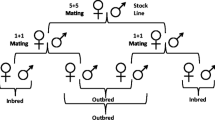Abstract
The model of isogenous strains with chromosome substitutions has been used to estimate the relative contributions of the X chromosome and autosomes (chromosomes 2 and 3) to the control of some mating behavior traits in Drosophila melanogaster. It has been found that the male sexual activity (SA), female sexual receptivity (SR), and copulation latency (CL) are determined by interaction between X-chromosome and autosomal genes, whereas the copulation duration (CD) is mainly controlled by the X-chromosome genes. The synthesized isogenous strains have been shown to be more similar to hybrids than to the original strains. In the offspring with hybrid genotypes, the relationships between all traits are less stable, which may be related with an increase in the heterozygosity level and changes in genetic homeostasis.
Similar content being viewed by others
References
Volkova, N.E. and Vorobjova, L.I., Inheritance Features of Mating Behavior Somronents in Drosophila melanogaster and Their Significance for Fitness, Russ. J. Genet., 2005, vol. 41, no. 5, pp. 490–494.
Volkova, N.E., Sheremet, O.Yu., and Vorobjova, L.I., Mating Behavior in Mutant Strains of Drosophila melanogaster at Different Population Densities, Russ. J. Genet., 2006, vol. 42, no. 4, pp. 392–396.
Kaidanov, L.Z., Analysis of Genetic Consequences of Selection and Inbreeding in Drosophila melanogaster, Zh. Obshch. Biol., 1979, vol. 60, no. 6, pp. 834–849.
Trut, L.N., Ocherki po genetike povedeniya (Studies on Behavioral Genetics), Novosibirsk: Nauka, 1978.
Ehrman, E. and Parsons, P., Behavioral Genetics and Evolution, New York: McGraw-Hill, 1981.
Volkova, N.E. and Vorobjova, L.I., Influence of Gene Mutations on Chromosomes 1 and 2 on the Sexual Behavior of Drosophila melanogaster, Visn. Odes’k. Nats. Univ., Ser. Biol., 2005, vol. 10, pp. 115–124.
Kaidanov, L.Z., Anisimova, L.E., and Litvinova, E.M., Genetic Studies on the Sexual Behavior of Drosophila melanogaster: III. Further Genetic Analysis of Strains Differing in Male Sexual Activity, Genetika (Moscow), 1972, vol. 8, no. 9, pp. 75–83.
Kaidanov, L.Z., Khuguto, N., and Iovleva, O.V., Concentration of Mutations Differing in the Effect on Viability in Selected Inbred Drosophila melanogaster Strains, Genetika (Moscow), 1983, vol. 19, no. 9, pp. 1451–1456.
Pole, I.R., Analysis of Genetic Determination of Sexual Activity in Male Drosophila melanogaster, Extended Abstract of Cand. Sci. (Biol.) Dissertation, Leningrad: Leningr. Gos. Univ., 1979.
Hall, J.C., The Mating of a Fly, Science, 1994, vol. 264, pp. 1702–1714.
Kerr, C., Ringo, J., Dowse, H., and Johnson, E., Isebox, a Recessive X-Linked Mutation in Drosophila Causing Low Sexual Receptivity, J. Neurogenet., 1997, vol. 11, pp. 213–229.
Khasan, A.M., Grigor’eva, N.N., and Shakhbazov, V.G., On the Contribution of the X Chromosome to a Higher Resistance of Interstrain Drosophila melanogaster Hybrids to Some Physical Factors, Genetika (Moscow), 1978, vol. 14, no. 1, pp. 87–92.
Reinhold, K., Sex Linkage among Genes Controlling Sexually Selected Traits, Behav. Ecol. Sociobiol., 1998, vol. 44, pp. 1–7.
Subocheva, E.A., Romanova, N.I., Karpova, N.N., et al., Male Reproduction Behavior in Drosophila melanogaster Strains with Different Alleles of the flamenso Gene, Russ. J. Genet., 2003, vol. 39, no. 5, pp. 553–558.
Clark, D.L. and Biesiadecki, B., Mating Success and Alternative Reproductive Strategies of the Dimorphic Jumping Spider, Maevia inclemens (Araneae, Salticidae), J. Arachnology, 2002, vol. 30, pp. 511–518.
Moehring, A.J. and Mackay, T.F.C., The Quantitative Genetic Basis of Male Mating Behavior in Drosophila melanogaster, Genetics, 2004, vol. 167, pp. 1249–1263.
Basso da Silva, I. and Valente, V.L.S., A Temporal Analysis of Sexual Activity in a Natural Population of Drosophila willistoni, Hereditas, 2000, vol. 133, pp. 211–216.
Ashburner, M., Drosophila: A Laboratory Handbook, New York: Cold Spring Harbor Lab., 2005, 2nd ed., pp. 540–542.
Lakin, G.F., Biometriya (Biometry), Moscow: Vysshaya Shkola, 1990.
Plokhinskii, N.A., Matematicheskie metody v biologii (Mathematical Methods in Biology), Moscow: Mosk. Gos. Univ., 1978.
Pasyukova, E.G., Belyaeva, E.S., Kogan, G.L., et al., Transpositions of Transposable Elements Correlated with Fitness Changes in Drosophila melanogaster, Genetika (Moscow), 1984, vol. 20, no. 11, pp. 1772–1781.
Vasil’eva, L.A., Ratner, V.A., and Bubenshchikova, E.V., Stress Induction of Retrotransposon Transpositions in Drosophila: Reality of the Phenomenon, Characteristic Features, and Possible Role in Raid Evolution, Russ. J. Genet., 1997, vol. 33, no. 8, pp. 918–928.
Ratner, V.A. and Vasil’eva, L.A., Stress Induction of Transposable Element Transpositions, Soros. Obraz. Zh., 2000, vol. 6, no. 6, pp. 14–20.
Taglina, O.V., Investigation of Spontaneous Asynapsis of Salivary Gland Polytene Chromosomes of Drosophila melanogaster in Highly Inbred Starins, Combined Strains, and Their Hybrids, Visn. Kharkivsk. Nats. Univ. im. V.N. Karazina, Ser. Biol., 2006, vol. 3, no. 729, pp. 136–140.
Lapta, G.E. and Shakhbazov, V.G., Disturbance of Polytene Chromosome Conjugation in Inbred Strains and Interstrain Hybrids of Drosophila melanogaster, Genetika (Moscow), 1976, vol. 12, no. 2, pp. 121–126.
Beaver, L.M. and Giebultowicz, Ja.M., Regulation of Copulation Duration by period and timeless in Drosophila melanogaster, Curr. Biol., 2004, vol. 14, no. 16, pp. 1492–1497.
Author information
Authors and Affiliations
Corresponding author
Additional information
Original Russian Text © N.E. Volkova, L.I. Vorobyova, 2008, published in Genetika, 2008, Vol. 44, No. 2, pp. 202–208.
Rights and permissions
About this article
Cite this article
Volkova, N.E., Vorobyova, L.I. Genetic analysis of the contributions of individual chromosomes to the expression of mating behavior traits in Drosophila melanogaster . Russ J Genet 44, 165–170 (2008). https://doi.org/10.1134/S1022795408020075
Received:
Published:
Issue Date:
DOI: https://doi.org/10.1134/S1022795408020075




